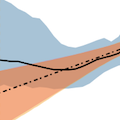Abstract
Background. In 2014-2015, 242 individuals aged 2–89 were newly HIV-1 diagnosed in Roka, a rural commune in Cambodia. A case-control study attributed the outbreak to unsafe injections. We aimed to reconstruct the likely transmission history of the outbreak.
Methods. We assessed in 209 (86.4%) HIV-infected cases the presence of hepatitis C and B viruses (HCV, HBV). We identified recent infections using antibody (Ab) avidity testing for HIV and HCV, and HBcIgM Ab for HBV. We performed evolutionary phylogenetic analyses of viral strains. Geographical coordinates and parenteral exposure through medical services provided by an unlicensed health care practitioner were obtained from 193 cases and 1499 controls during interviews.
Results. Cases were co-infected with HCV (78.5%) and HBV (12.9%). We identified 79 (37.8%) recent (<130 days) HIV infections. Phylogeny of 202 HIV env C2V3 sequences showed a 198-sample CRF01_AE strains cluster, with time to most recent common ancestor (tMRCA) in September 2013 (95% highest posterior density, August 2012–July 2014), and a peak of 15 infections/day in September 2014. Three geospatial HIV hotspots were discernible in Roka and correlated with high exposure to the practitioner (P=0.04). Fifty-nine (38.6%) of 153 tested cases showed recent (<180 days) HCV infections. Ninety HCV NS5B sequences formed three main clades, one containing 34 subtypes 1b with tMRCA in 2012, and two with 51 subtypes 6e and tMRCAs in 2002-2003.
Conclusions. Unsafe injections in Cambodia most likely led to an explosive iatrogenic spreading of HIV, associated with a long-standing and more genetically-diverse HCV propagation.
